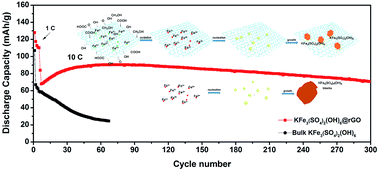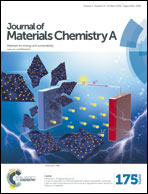Direct growth of an economic green energy storage material: a monocrystalline jarosite-KFe3(SO4)2(OH)6-nanoplates@rGO hybrid as a superior lithium-ion battery cathode†
Abstract
The exploration of new inexpensive rechargeable batteries with high energy-density electrodes is a key to integrate renewable sources such as solar and wind, and address sustainability issues. Herein, a facile and scalable method is developed to prepare a two-dimensional earth-abundant jarosite-KFe3(SO4)2(OH)6/rGO hybrid via a solution-phase oxidation process at elevated temperature. In this synthesis, single-layer graphene sheets serve as both structure-directing agents and growth platforms to directly grow monocrystalline KFe3(SO4)2(OH)6 nanoplates with unique hexagonal shapes, forming a KFe3(SO4)2(OH)6/rGO hybrid. As a cathode for lithium batteries, the hybrid structure exhibits a high reversible capacity of 120.5 mA h g−1 after 100 cycles at a specific current of 2C and thus retains 88% of the maximum capacity. The monocrystalline jarosite-KFe3(SO4)2(OH)6-nanoplates/rGO hybrid exhibits a discharge capacity of 143.6, 113.9, 98.2, 83.9 and 65.9 mA h g−1 at 1, 2, 5, 10, and 20C, respectively, and retains a specific capacity of 134.4 mA h g−1 when the specific current returns from 20C to 1C, displaying an excellent rate capability. At a high rate of 10C, the jarosite-KFe3(SO4)2(OH)6/rGO composites maintained 70.7 mA h g−1 after 300 cycles with a capacity retention of 78.2%, indicating remarkable cycling stability even at a high rate. Compared with KFe3(SO4)2(OH)6 particles, the KFe3(SO4)2(OH)6/rGO nanocomposites exhibit remarkably prolonged cycling life and improved rate capability. Therefore, the earth-abundant jarosite-KFe3(SO4)2(OH)6/rGO hybrid demonstrates great potential for application as a high-performance cathode material in new-generation lithium-ion rechargeable batteries.


 Please wait while we load your content...
Please wait while we load your content...